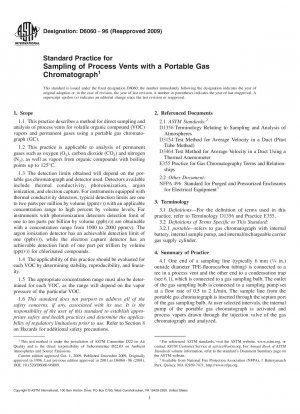ASTM D6060-96(2009)
Standard Practice for Sampling of Process Vents With a Portable Gas Chromatograph
- Standard No.
- ASTM D6060-96(2009)
- Release Date
- 1996
- Published By
- American Society for Testing and Materials (ASTM)
- Status
- Replace By
- ASTM D6060-17
- Latest
- ASTM D6060-17
- Scope
This practice has been widely used to obtain mass balance data for process scrubbers, to determine the efficiency of VOC emission control equipment, and to obtain data to support air permit applications.
This practice will have applications to the MACT Rule and may have applications to Compliance Assurance Monitoring verification required by the 1990 Clean Air Act Title III Amendments.
This practice, when used with Test Methods D3464 or D3154 or on-line process flow meter data, can be used to calculate detailed emission rate profiles for VOCs from process vents.
This practice provides nearly real time results that can detect process changes or upsets that may be missed using conventional sorbent tube or integrated gas sampling bag sampling.
1.1 This practice describes a method for direct sampling and analysis of process vents for volatile organic compound (VOC) vapors and permanent gases using a portable gas chromatograph (GC).
1.2 This practice is applicable to analysis of permanent gases such as oxygen (O2), carbon dioxide (CO2) and nitrogen (N2), as well as vapors from organic compounds with boiling points up to 125°C.
1.3 The detection limits obtained will depend on the portable gas chromatograph and detector used. Detectors available include thermal conductivity, photoionization, argon ionization, and electron capture. For instruments equipped with thermal conductivity detectors, typical detection limits are one to two parts per million by volume (ppm(v)) with an applicable concentration range to high percent by volume levels. For instruments with photoionization detectors detection limit of one to ten parts per billion by volume (ppb(v)) are obtainable with a concentration range from 1000 to 2000 ppm(v). The argon ionization detector has an achievable detection limit of one (ppb(v)), while the electron capture detector has an achievable detection limit of one part per trillion by volume (ppt(v)) for chlorinated compounds.
1.4 The applicability of this practice should be evaluated for each VOC by determining stability, reproducibility, and linearity.
1.5 The appropriate concentration range must also be determined for each VOC, as the range will depend on the vapor pressure of the particular VOC.
1.6 This standard does not purport to address all of the safety concerns, if any, associated with its use. It is the responsibility of the user of this standard to establish appropriate safety and health practices and determine the applicability of regulatory limitations prior to use. Refer to Section 8 on Hazards for additional safety precautions.
ASTM D6060-96(2009) Referenced Document
- ASTM D1356 Standard Terminology Relating to Sampling and Analysis of Atmospheres*, 2024-04-19 Update
- ASTM D3154 Standard Test Method for Average Velocity in a Duct (Pitot Tube Method)*, 2023-01-01 Update
- ASTM D3464 Standard Test Method for Average Velocity in a Duct Using a Thermal Anemometer*, 2023-01-01 Update
- ASTM E355 Standard Practice for Gas Chromatography Terms and Relationships*, 2024-04-19 Update
ASTM D6060-96(2009) history
- 2017 ASTM D6060-17 Standard Test Method for Sampling of Process Vents with a Portable Gas Chromatograph
- 1996 ASTM D6060-96(2009) Standard Practice for Sampling of Process Vents With a Portable Gas Chromatograph
- 1996 ASTM D6060-96(2001) Standard Practice for Sampling of Process Vents With a Portable Gas Chromatograph
- 1996 ASTM D6060-96 Standard Practice for Sampling of Process Vents With a Portable Gas Chromatograph
